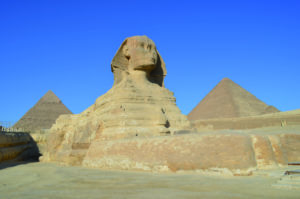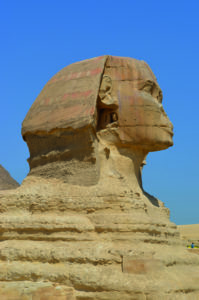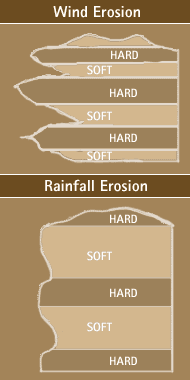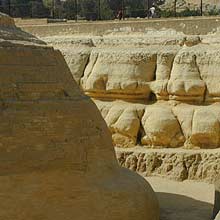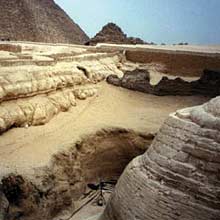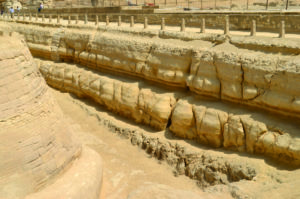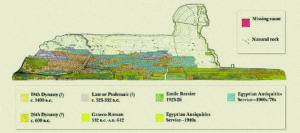The Sphinx and its meaning
On the eastern side of the Giza Plateau there was originally rock cliff that was 10 meters / 32.8 feet high. From it was carved a lion figure with a human head: the Sphinx. It measure a total of 62 meters / 203.4 feet long; the front paws alone are 15 meters / 49.2 feet long and the head is 20 meters / 65.6 feet tall. To form the body, a trench was cut out of the surrounding rock measuring 7.6 meters / 22 feet deep and 5.5 meters / 18 feet wide. After the discovery of the Sphinx and the Valley Temple (see page 66), it became clear that the limestone blocks of these structures, as were those used to build the Mortuary Temple in front of the Pyramid of Chephren, all came from the Sphinx trench. The building of the Sphinx is traditionally attributed to Chephren. The proof offered for this is based on the Diorite statute of a seated Chephren found in the Valley Temple (see page 67). Sited as further evidence is an inscription on the Dream Stele found in front of the Sphinx, which was erected by Thutmosis IV, who lived over a thousand years after Chephren. The name Chephren is inscribed on the stele, although the context in which it is used is no longer decipherable.
The respected Egyptologist, Professor C. Gaston Maspöro, commented about this in the year 1900:
“The Sphinx stele bears the name Chephren in the 13th line in the middle of a gap. (
) In my opinion, it indicates that the Sphinx was excavated and restored in time of this ruler, and consequently, provides more or less certain proof that it had already been buried in the sand in the days of his ancestors.”
In all probability, the present Sphinx head is not the original, because it is proportionally far too small in relation to the body. The other Giza structures demonstrate a sophisticated sense of proportion and even the later sphinxes from the Pharaohic period had lion, ram or human heads that matched the size of the body. Therefore, one can assume that the original head of the Sphinx in front of the Giza pyramids was well-worn after the long period of rain and a new face was chiseled out of the remaining rock with a narrow beard, a nemes headdress and the uraus cobra on its forehead. The broken off beard was found near the Sphinx and is today found in the British Museum in London, joined by the nose, which was shot off by Turkish cannonballs. The typical Egyptian kingly attributes (long, narrow beard, uraus cobra, nemes headdress) do indicate that a pharaoh redesigned the head of the Sphinx.
The controversy about the Sphinx and its age
The Pharaoh Chephren, son of Cheops, is considered to have been the creator of this fascinating sculpture. The body of Sphinx is extensively weathered and has been restored multiple times through the millennia. Egyptologists attribute this erosion to the wind, although the Sphinx stands in a trench and was buried in sand for most of the 4,500 years that have passed the days of Chephren. The Greek historian, Herodotus, who traveled through Egypt in the 5th century BC, reported about all three Giza pyramids, but failed to make any mention of the Sphinx, which leads us to conclude that it was fully covered by sand in that period.
If the desert wind truly did cause the erosion, then the sandstone structures from the 4th Dynasty should at least show signs of the same degree of weathering, which simply is not the case. The vertical, 0.9 to 1.8 meter / 3 to 6 feet deep grooves in the trench walls seem to indicate massive water flows, which must have arisen from powerful and plentiful rain storms, which were last experienced in Egypt over 10,000 years ago.
The traces of water erosion on the Sphinx were first noticed by the French mathematician and symbol researcher, R. A. Schwaller de Lubicz, who carried out extensive research in Egypt in the 1940s. In his book, Sacred Science - The King of Pharaonic Theocracy, he stated: “A highly evolved culture must have existed in Egypt before it was inundated by a natural catastrophe in the 11th century BC. We conjecture that the Sphinx already existed back then, because the body of the lion shows clears traces of water erosion.”
Determination of age by West and Schoch in 1992
Thirty years later, the American Egypt researcher, John Anthony West, thoroughly analyzed the observation of his French predecessor in his 1979 book, Serpent in the Sky. Because the official Egyptology categorically denied the existence of water erosion, in 1989, West turned to Geology Professor, Robert Schoch, of the University of Boston, a noted specialist for erosion profiles. Despite having grave doubts in the water erosion hypothesis, Schoch went to Egypt the following year, firm in his conviction that the age of the Sphinx had long been incontrovertibly determined.
Although he could only observe the Sphinx from the visitors platform, it was immediately clear to Dr. Schoch that the sculpture showed traces of water erosion. To make a scientifically-founded assessment, however, the stone itself needed to be examined, an undertaking which the Egyptian Antiquities Administration approved upon the recommendation of the University of Boston.
John West put together a high-carat team that included Professor Schoch, the Geophysicist, Dr. Thomas L. Dobecki of Houston, two other geologists, an architect, a photographer and the filmmaker, Boris Said. The scientifically conducted analysis of the limestone structures of the Sphinx and its surroundings confirmed that the traces of erosion were caused by precipitation. Dr. Dobecki, who also conducted seismographic tests to map the erosion traces below the ground, stumbled across an unexpected abnormality, which indicated that there was a hollow space beneath the Sphinx, measuring around 9 meters / 29.5 wide, 12 meters / 39.4 feet long and 5 meters / 16.5 high.
When the team presented its results to the 1992 annual meeting of the Geological Society of America, many geologists were confronted with scientific proof, which showed to their amazement that after two hundred years of Giza research, water erosion caused by precipitation had been detected on the Sphinx. In stark contrast to this reaction was the vehemence with which Egyptologists disputed and continue to dispute these findings, which essentially prove that the Sphinx must have been in existence during the great rainfalls in Egypt 10,000 years BC.
rofessor Schochs results were confirmed in the following years by other geologists, including Dr. David Coxhill and Professor Colin Reader from the London University, a fact which was, however, barely reported in the media.
This is an excerpt from the book GIZA LEGACY.


